Biringen S., Chow C.-Y. An Introduction to Computational Fluid Mechanics by Example
Подождите немного. Документ загружается.


262 NUMERICAL SOLUTION OF THE INCOMPRESSIBLE NAVIER-STOKES EQUATION
Now taking the x derivative of (4.5.21) and imposing (∂u/∂x)
n+1
i
= 0, we get
t
∂
2
P
n+1
i
∂x
2
=
∂u
n
i
∂x
(4.5.22)
With second-order central differences we obtain
P
n+1
i+1
−2P
n+1
i
+P
n+1
i−1
=
x
2t
u
n
i+1
−u
n
i−1
(4.5.23)
We note that in (4.5.23) P
n+1
i
is not influenced by u
n+1
i
, and in (4.5.21), u
n+1
i
is not influenced by P
n+1
i
. Therefore, pressure and velocity are decoupled at
odd–even points. This can lead to high-frequency oscillations necessitating the
use of artificial viscosity to smoothen the solutions.
Let us now consider a staggered grid arrangement as shown in Fig. 4.5.2.
Again, with second-order central differences about grid point (i +
1
2
), (4.5.19)
is written as
u
n+1
i+1/2
= u
n
i+1/2
−
t
x
P
n+1
i+1
−P
n+1
i
(4.5.24)
Taking the x derivative of (4.5.24), and setting
∂u
∂x
n+1
i+1/2
= 0 (4.5.25)
satisfying mass conservation (4.5.20) at time level (n + 1), we obtain in dis-
cretized form
P
n+1
i+1
−2P
n+1
i
+P
n+1
i−1
=
x
t
u
n
i+1/2
−u
n
i−1/2
(4.5.26)
For the staggered mesh, an examination of (4.5.24) and (4.5.26) reveals that
the P nodes at grid location i and the u nodes at grid location (i +
1
2
)arealways
coupled. At high-Reynolds numbers, with central differences, high-frequency
oscillations may still persist, but these generally will have lower amplitudes and
occur at higher Reynolds numbers than those on collocated grids. In such cases,
staggered grids with high-order upwind or upwind biased differences may be
preferable (Rai and Moin, 1991).
We will now consider the full two-dimensional, time dependent Navier-Stokes
(momentum conservation equation) and continuity equations for incompressible
flows in x-y rectangular coordinates. The convective terms will be written in
P
i
P
i + 1
P
i − 1
u
i − 1/2
u
i + 1/2
FIGURE 4.5.2 Velocity and pressure nodes on a staggered grid.

PRIMITIVE VARIABLE FORMULATION: NUMERICAL INTEGRATION 263
conservative form which preserves mass and momentum in the discrete form of
the equations (Roache, 1972). The conservative form of the convective terms are
obtained from equation (4.5.2):
V ·∇V = ∇ · (VV) − V∇ ·V (4.5.27)
Noting that by continuity (4.5.1),
V∇ · V = 0 (4.5.28)
it then follows that for the x momentum equation of motion, we obtain
V · ∇V =
∂u
2
∂x
+
∂uv
∂y
(4.5.29)
and for the y momentum equation, the conservative form of the convective term is
V · ∇V =
∂uv
∂x
+
∂v
2
∂y
(4.5.30)
The x and y components of the equation of motion in nondimensional form can
now be written respectively as
∂u
∂t
+
∂u
2
∂x
+
∂uv
∂y
= Re
−1
∂
2
u
∂x
2
+
∂
2
u
∂y
2
−
∂P
∂x
(4.5.31)
∂v
∂t
+
∂uv
∂x
+
∂v
2
∂y
= Re
−1
∂
2
v
∂x
2
+
∂
2
v
∂y
2
−
∂P
∂y
(4.5.32)
Considering the P, u,andthev nodes in the MAC configuration (Fig. 4.5.3),
the x-momentum equation is written at the u nodes, and the y-momentum
equation is written at the v nodes. Accordingly, the various derivatives in the
x-momentum equation (4.5.31) are calculated as follows:
∂u
∂t
n+1
i+1/2, j
=
u
n+1
i+1/2, j
−u
n
i+1/2, j
t (4.5.33)
∂
2
u
∂x
2
n+1
i+1/2, j
=
u
n+1
i−1/2, j
−2u
n+1
i+1/2, j
+u
n+1
i+3/2, j
x
2
(4.5.34)
∂P
∂x
n+1
i+1/2, j
=
P
n+1
i+1, j
−P
n+1
i, j
x (4.5.35)
Using the MAC method, the other terms in the u-momentum equation (4.5.31)
are written as
∂u
2
∂x
n
i+1/2, j
=
u
2
i+1, j
−u
2
i, j
n
x (4.5.36)
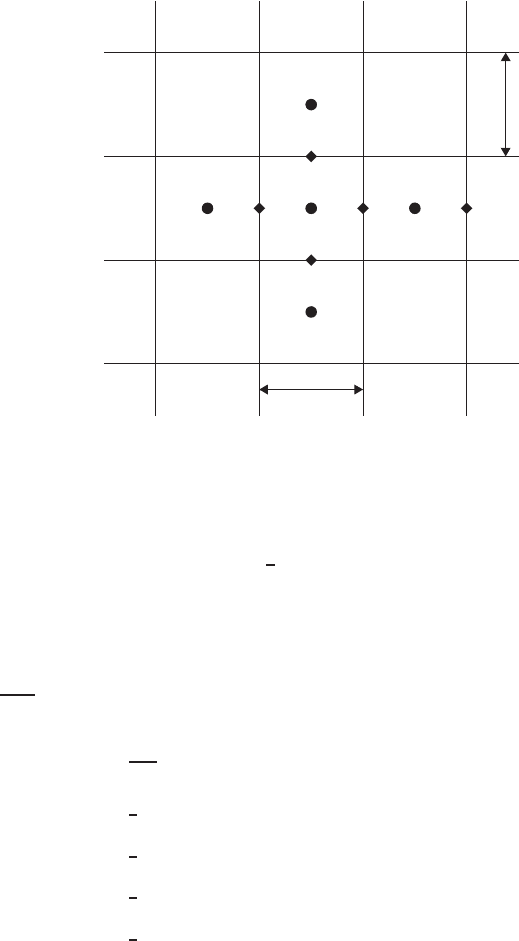
264 NUMERICAL SOLUTION OF THE INCOMPRESSIBLE NAVIER-STOKES EQUATION
P
i, j + 1
P
i + 1, j
P
i, j
P
i − 1, j
P
i, j − 1
u
i − 1/2, j
u
i + 1/2, j
u
i + 3/2, j
v
i, j − 1/2
v
i, j + 1/2
Δ
y
Δx
FIGURE 4.5.3 MAC staggered grid system.
But we note that u
i+1, j
is not defined on a u node, so that to obtain this quantity,
we use averaging such that
u
i+1, j
=
1
2
u
i+1/2, j
+u
i+3/2, j
(4.5.37)
Finally, the product term ∂uv/∂y will be evaluated as the product of averages,
not as the average of the products, so that
∂uv
∂y
i+1/2, j
=
(uv)
i+1/2, j +1/2
−(uv)
i+1/2, j −1/2
y
=
1
y
u
i+1/2, j +1/2
v
i+1/2, j +1/2
−
u
i+1/2, j −1/2
v
i+1/2, j −1/2
u
i+1/2, j +1/2
=
1
2
u
i+1/2, j
+u
i+1/2, j +1
v
i+1/2, j +1/2
=
1
2
v
i, j +1/2
+v
i+1, j +1/2
(4.5.38)
u
i+1/2, j −1/2
=
1
2
u
i+1/2, j −1
+u
i+1/2, j
v
i+1/2, j −1/2
=
1
2
v
i, j −1/2
+v
i+1, j −1/2
For simplicity, we will implement a fully explicit version of the time-splitting
(fractional time-step) method described by (4.5.5)–(4.5.18) using the Euler
explicit scheme (4.4.10) for both the viscous and the diffusion terms. This
method is O(t, x
2
) with second-order central differences in space, and when

PRIMITIVE VARIABLE FORMULATION: NUMERICAL INTEGRATION 265
applied to the x-momentum equation on the staggered grid from time level t to
ˆ
t yields the following equation at the intermediate step:
ˆu
i+1/2, j
−u
n
i+1/2, j
t
=
(u
n
i, j
)
2
−
u
n
i+1, j
2
x
+
(uv)
n
i+1/2, j −1/2
−(uv)
n
i+1/2, j +1/2
y
+
1
Re x
2
u
n
i+3/2, j
−2u
n
i+1/2, j
+u
n
i−1/2, j
+
1
Re y
2
u
n
i+1/2, j +1
−2u
n
i+1/2, j
+u
n
i+1/2, j −1
(4.5.39)
Similarly for the y-momentum equation we obtain the following equation:
ˆv
i, j +1/2
−v
n
i, j +1/2
t
=
(uv)
n
i−1/2, j +1/2
−(uv)
n
i+1/2, j +1/2
x
+
v
n
i, j
2
−(v
n
i, j +1
)
2
y
+
1
Re x
2
v
n
i+1, j +1/2
−2v
n
i, j +1/2
+v
n
i−1, j +1/2
+
1
Re y
2
v
n
i, j +3/2
−2v
n
i, j +1/2
+v
n
i, j −1/2
(4.5.40)
Practical stability requirements obtained from the von Neumann analysis for
the Euler explicit solver are given by Peyret and Taylor (1983, p. 148) as follows:
0.25(|u|+|v|)
2
t Re ≤ 1
t
Re x
2
≤ 0.25, assuming that x = y (4.5.41)
It is also possible to maintain stability considering the values of the following
quantities (Moin et al., 1978; Huser and Biringen, 1992),
c
1
(t) = max
i, j
(|u
i, j
|/x
i
+|v
i, j
|/y
j
)t
c
2
(t) = max
i, j
t
Re
1
(x
i
)
2
+
1
(y
j
)
2
(4.5.42)
In general, a stable solution will be obtained for c
1
(t) less than about 0.5 and
c
2
(t) less than about 0.1. However, in actual computations, these values are
determined by trial and error.
In the MAC grid, explicit boundary condition (Fig. 4.5.4) on the pressure are
not needed with the time-splitting method, but the implementation of boundary
conditions on the velocity components is more complicated than in collocated
grids. At a horizontal wall, boundary conditions for the velocities parallel to the

266 NUMERICAL SOLUTION OF THE INCOMPRESSIBLE NAVIER-STOKES EQUATION
u
i + 1/2, 2
v
i, j + 1/2
u
i − 1/2, 1
u
i − 1/2, −1
u
i + 1/2, 1
(i, j)
(fictitious point)
v
Γ
u
Γ
FIGURE 4.5.4 MAC grid boundary conditions for the u velocity near a horizontal wall.
walls are obtained using averaging, which gives
u
=
1
2
(u
i+1/2,1
+u
i+1/2,−1
)
u
i+1/2,−1
= 2u
−u
i+1/2,1
(4.5.43)
We note that (4.5.43) is equivalent to linear extrapolation and u
i+1/2,−1
is the
velocity at the first u node outside the physical boundary (fictitious point).
Higher-order extrapolations are also possible as given by Peyret and Taylor (1983,
p. 150), such as
u
i+1/2,−1
=
1
3
(u
i+1/2,2
−6u
i+1/2,1
+8u
) (4.5.44)
The velocity u
in (4.5.43) and (4.5.44) is the specified wall velocity; for example,
as u
= 0 for a stationary wall and u
= 1 for a horizontal wall moving from
left to right when the velocity scale is chosen as u
. On the horizontal wall v
nodes exist, so that the no-slip boundary condition v
= 0 (stationary wall) can
be directly imposed. On a vertical wall, where u nodes exist and v nodes do not,
similar boundary conditions as in (4.5.43) and (4.5.44) can be obtained for v.
It should be noted that the second step of the time-splitting procedure with
the Euler explicit method cancels the convective and viscous terms exactly as
shown below. Advancing (4.5.2) from time step t
n
to
ˆ
t gives
ˆ
V − V
n
t
=−H
n
+
1
Re
∇
2
V
n
(4.5.45)
Now, advancing (4.5.2) from time step t
n
to t
n+1
, we obtain
V
n+1
−V
n
t
=−H
n
+
1
Re
∇
2
V
n
−∇P
n+1
(4.5.46)
Subtracting (4.5.45) from (4.5.46), we find
V
n+1
−
ˆ
V
t
=−∇P
n+1
(4.5.47)
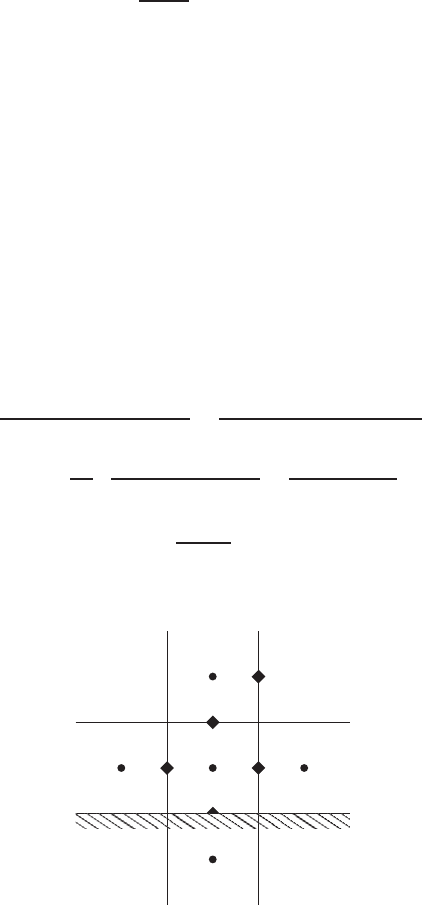
PRIMITIVE VARIABLE FORMULATION: NUMERICAL INTEGRATION 267
We now impose zero divergence of the velocity field at time level (n + 1),
∇ · V
n+1
= 0, so that taking the divergence of (4.5.47), one obtains the elliptic
pressure equation:
∇ ·
ˆ
V
t
=∇
2
P
n+1
(4.5.48)
From (4.5.48), we infer that the scalar quantity that projects zero divergence of
the velocity field at time level (n + 1) is the thermodynamic pressure (normalized
by the constant density); hence, with the fully explicit methods there is no need
to extract pressure from φ, which is required for semi-implicit time advancement
if the pressure solution is desired.
Pressure boundary conditions are all homogeneous Neumann boundary con-
ditions, given by ∂P
n+1
/∂n = 0, where ∂/∂n denotes differentiation along the
normal to the boundary. This boundary condition is derived from (4.5.47) with
V
n+1
= V
n
=
ˆ
V at the boundaries, provided that ∂P/∂n = 0 at the first time step.
The accuracy of these boundary conditions have been documented by Gresho
(1991) and Kim and Moin (1985).
To demonstrate how pressure boundary conditions are implemented, consider
the computational cell adjacent to a horizontal wall (Fig. 4.5.5). Writing the
pressure equation (4.5.48) at grid location (i, j), for an impermeable wall gives
P
n+1
i,2
−2P
n+1
i,1
+P
n+1
i,−1
y
2
+
P
n+1
i+1,1
−2P
n+1
i,1
+P
n+1
i−1,1
x
2
=
1
t
ˆu
i+1/2,1
− ˆu
i−1/2,1
x
+
ˆv
i,1+1/2
− ˆv
y
P
n+1
i,−1
= P
n+1
i,1
from
∂P
n+1
∂n
= 0
(4.5.49)
ˆv
= v
n+1
= 0 (stationary wall)
u
i + 1/2, 2
v
i, 1 + 1/2
u
i − 1/2, 1
u
i + 1/2, 1
P
i, 1
P
i, −1
(fictitious point)
P
i + 1, 1
P
i − 1, 1
P
i, 2
v
Γ
FIGURE 4.5.5 Computational cell adjacent to a horizontal wall, pressure boundary
conditions.
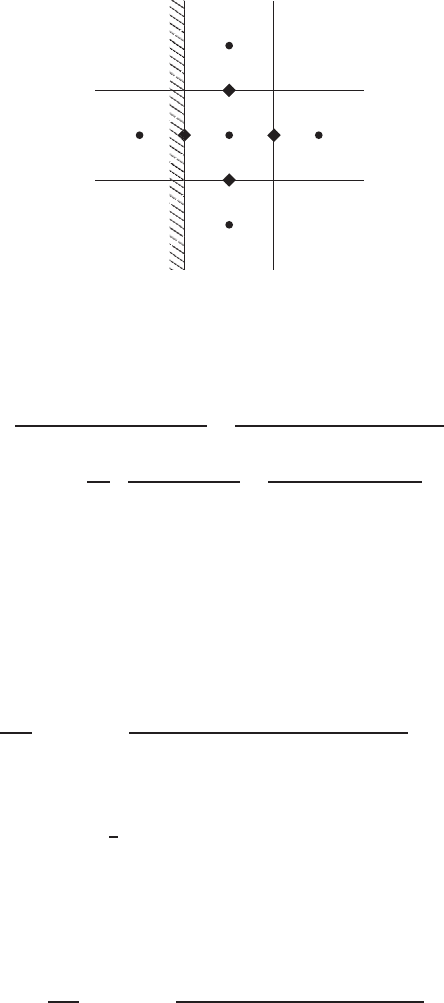
268 NUMERICAL SOLUTION OF THE INCOMPRESSIBLE NAVIER-STOKES EQUATION
v
1, j + 1/2
u
1 + 1/2, j
v
1, j − 1/2
P
1, j
P
1, j − 1
P
2, j
P
−1, j
P
1, j + 1
u
Γ
FIGURE 4.5.6 Computational cell adjacent to a vertical wall, pressure boundary conditions.
With similar boundary conditions for a vertical wall as in Figure 4.5.6, the pres-
sure equation becomes
P
n+1
2, j
−2P
n+1
1, j
+P
n+1
−1, j
x
2
+
P
n+1
1, j +1
−2P
n+1
1, j
+P
n+1
1, j −1
y
2
=
1
t
ˆu
1+1/2, j
− ˆu
x
+
ˆv
1, j +1/2
− ˆv
1, j −1/2
y
P
n+1
−1, j
= P
n+1
1, j
(4.5.50)
ˆu
= u
n+1
= 0 (stationary wall)
It is important to recognize that the moving wall boundary conditions will be
imposed on the solution during the calculation of the viscous terms (also by the
convective terms through averaging). Consider the y-directional viscous term in
the x-momentum equation (4.5.39). Referring to Fig. 4.5.7 we obtain
∂
2
u
∂y
2
n
i+1/2, j
=
u
n
i+1/2, j −1
−2u
n
i+1/2, j
+u
n
i+1/2,+1
y
2
(4.5.51)
The velocity outside of the computational domain, u
n
i+1/2,+1
, is calculated by
averaging:
1
2
u
n
i+1/2,+1
+u
n
i+1/2, j
= u
n
(4.5.52)
From this expression one can obtain u
n
i+1/2,+1
considering that for the stationary
wall u
n
= 0, and for the wall moving with constant velocity normalized by itself
(which is the maximum velocity in the computational domain), u
n
= 1.
For the y-directional viscous term in the y-momentum equation, we obtain
∂
2
v
∂y
2
n
i, j −1/2
=
v
n
i, j −3/2
−2v
n
i, j −1/2
+v
n
i, j +1/2
y
2
(4.5.53)
At the upper (impermeable) wall, we define v
n
i, j +1/2
= v
n
= 0.
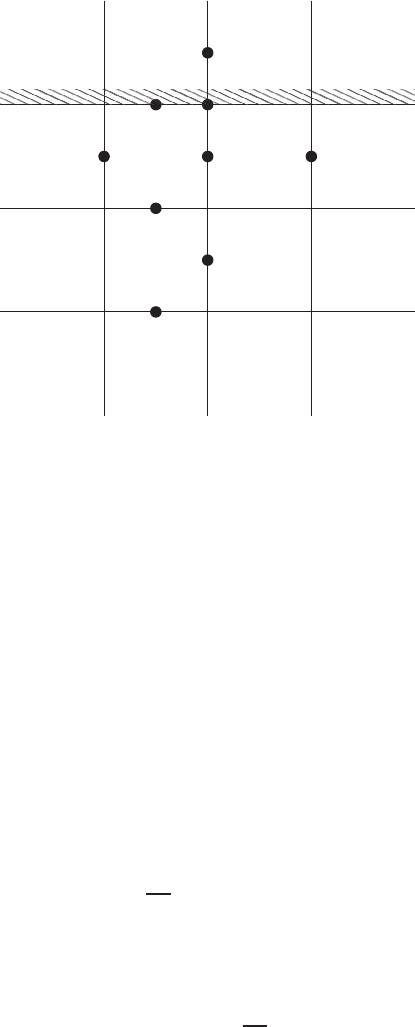
PRIMITIVE VARIABLE FORMULATION: NUMERICAL INTEGRATION 269
u
i + 1/2, j − 1
u
i − 1/2, j
u
i + 1/2, j
u
i + 3/2, j
v
Γ
u
Γ
= 1
u
i + 1/2, +1
V
i, j − 3/2
V
i, j − 1/2
(fictitious point)
FIGURE 4.5.7 Evaluation of the viscous terms at the horizontal upper wall.
Elliptic equations with Neumann boundary conditions on all boundaries, such
as the pressure equation (4.5.48), present an indeterminate problem, as the coef-
ficient matrix of the finite-difference representation of the equation has one zero
eigenvalue. Consequently, the resulting system of equations is linearly dependent
and cannot be solved uniquely (Mitchell, 1969, p. 118). This can be alleviated
by assigning a constant value to pressure at one reference point in the solution
domain. The resulting equations will be linearly independent, and will have a
unique solution for an arbitrary value of the constant. Thus, the pressure solution
will be off by this constant, but the pressure gradient, which is the actual term
that exists in the equation of motion, will be correctly calculated. In the Neumann
problem for elliptic equations, the other issue is to globally satisfy an integral
constraint. Consider the following Laplace equation:
∇
2
φ = 0 (4.5.54)
subject to the boundary conditions
∂φ
∂n
= g(x
1
, x
2
) (4.5.55)
These boundary conditions will be applied on the boundary of the unit square,
0 ≤ x
1
, x
2
≤ 1, where ∂/∂n is the normal derivative. Using the divergence
theorem, we get
S
(∇
2
φ) dS =
L
∂φ
∂n
dl = 0 (4.5.56)

270 NUMERICAL SOLUTION OF THE INCOMPRESSIBLE NAVIER-STOKES EQUATION
In (4.5.56), S is the surface of the unit square, and L is the perimeter. Accordingly,
dS is the element of area in S ,anddl is the element of length along L. Substituting
from the right-hand side of (4.5.55), we obtain
L
∂φ
∂n
dl =
L
g(x
1
, x
2
) dl = 0
L
g(x
1
, x
2
) dl = 0
(4.5.57)
Similarly for the elliptic Poisson equation,
∇
2
φ = f (x
1
, x
2
) (4.5.58)
with the boundary conditions as before, the integral constraint becomes
S
f (x
1
, x
2
) dS =
L
∂φ
∂n
dl =
L
g(x
1
, x
2
) dl
L
g(x
1
, x
2
) dl =
S
f (x
1
, x
2
) dS
(4.5.59)
For all elliptic equations with Neumann boundary conditions, (4.5.57) or (4.5.59)
must be satisfied by the discrete form of the equations. It is very important to
note that in the MAC staggered grid system, the discretized form of the pressure
Poisson equation automatically satisfies the discrete form of (4.5.59), obviating
the need for any adjustments to the right-hand side of the Poisson equation
(Fletcher, 2006), which is required in collocated mesh systems.
Let us again consider Poisson’s equation (4.5.58) with the Neumann boundary
conditions (4.5.55). Using second-order central differences and with x = y =
h, at a grid point (i, j ) (4.5.58) can be written as
φ
i+1, j
−2φ
i, j
+φ
i−1, j
h
2
+
φ
i, j +1
−2φ
i, j
+φ
i, j −1
h
2
= f (x
i
, y
j
) (4.5.60)
For the interior points, simplifying (4.5.60) leads to
φ
i+1, j
+φ
i−1, j
+φ
i, j +1
+φ
i, j −1
−4φ
i, j
= h
2
f
ij
i = 1, 2, ..., N
j = 1, 2, ..., N
(4.5.61)
We evaluate this equation in the computational domain comprising a unit square
as shown in Fig. 4.5.8, with N = 2, i.e., with 4 interior grid points. Writing
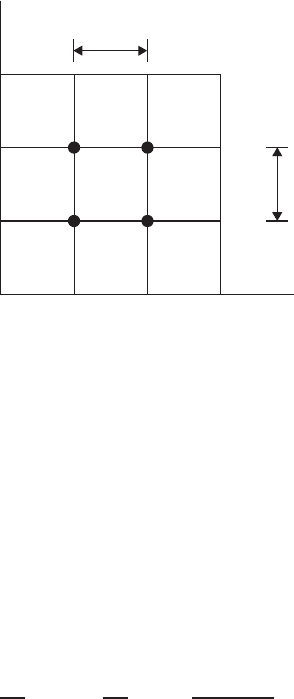
PRIMITIVE VARIABLE FORMULATION: NUMERICAL INTEGRATION 271
h
h
0, 3 1, 3 2, 3
2, 21, 20, 2
0, 1 1, 1 2, 1 3, 1
3, 2
3, 3
3, 02, 01, 00, 0
x (i)
y (j)
FIGURE 4.5.8 Schematic for the Poisson equation (4.5.62).
(4.5.61) for each node, the following system of linear equations is obtained:
φ
21
+φ
01
+φ
10
+φ
12
−4φ
11
= h
2
f
11
(1,1)
φ
31
+φ
11
+φ
20
+φ
22
−4φ
21
= h
2
f
21
(2,1)
φ
22
+φ
02
+φ
11
+φ
13
−4φ
12
= h
2
f
12
(1,2)
φ
32
+φ
12
+φ
21
+φ
23
−4φ
22
= h
2
f
22
(2,2)
(4.5.62)
The boundary points φ
i0
, φ
0j
, φ
i3
, φ
3j
will be approximated by using first-
order differences directed away from the interior of the square, for example, at
i = 1, j = 0:
∂φ
∂n
1,0
=
∂φ
∂y
1,0
=
φ
11
−φ
10
h
= g
10
φ
10
= φ
11
−hg
10
(4.5.63)
Using (4.5.63) to eliminate φ
10
, the finite difference equation at node (1,1) sim-
plifies to
φ
21
+φ
12
−2φ
11
= h
2
f
11
+hg
01
+hg
10
= r
11
(4.5.64)
Similarly, for the other interior nodes the corresponding finite difference
equations are
φ
11
+φ
22
−2φ
21
= h
2
f
21
+hg
31
+hg
20
= r
21
(4.5.65)
φ
11
+φ
22
−2φ
12
= h
2
f
12
+hg
02
+hg
13
= r
12
(4.5.66)
φ
21
+φ
12
−2φ
22
= h
2
f
22
+hg
32
+hg
23
= r
22
(4.5.67)
